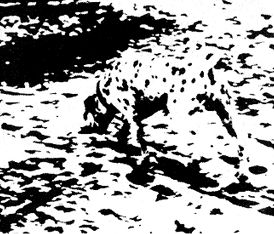
Vagueness
Taxonomy: Logical Fallacy > Informal Fallacy > Vagueness
Subfallacy: The Fallacy of the Heap
Exposition:
Vagueness is a characteristic of language, specifically of those words and phrases that classify or qualify objects, that is, common nouns and adjectives. Such a word or phrase divides the world of objects into those it applies to1, and those to which it doesn't apply. For example, the common noun "elephant" divides the world into elephants and non-elephants.
What characterizes a vague term is the existence of borderline cases which do not clearly belong or not belong to its extension. For example, consider the familiar common noun "chair": some things are clearly chairs—what you're sitting on right now, for instance—and others are clearly not—for instance, an elephant, even though you might sit upon one. But there are many borderline cases: barstools, beanbag "chairs", school desks, etc.
The fallacy of Vagueness comes about when the appearance of cogency of an argument depends upon vagueness in its terms.
The mere fact of vagueness is not sufficient to justify an accusation of fallacy, but it is sometimes a logical boobytrap which can cause the unsuspecting person to fall into fallacious reasoning. For this reason, it is useful to be aware of and on our guard against vague terms, so that we can continue to use our vague language without being ensnared by it.
As a logical fallacy, Vagueness is the most general fallacy in which the fallaciousness of an argument turns on vague language. This is why no Example is given for this fallacy, as instances should be examples of a subfallacy.
Exposure:
- Vagueness should be distinguished from ambiguity: an ambiguous term has more than one meaning, whereas vagueness is characteristic of a single meaning that has borderline cases. However, it is not unusual for a term to be both ambiguous and vague; in fact, this is the usual case.
- Vagueness is frequently confused with over-generality, and overly-general terms are often called "vague". However, while an overly-general term is imprecise, it is not so because of borderline cases. For example, suppose that I tell you that there's a "mammal" in your backyard, which is true but not very informative. Instead, I should say that there's a "bear" there, which is more specific. "Mammal" is more general than "bear", and perhaps overly-general in the context, but it is not vaguer.
- Vagueness is a pervasive characteristic of natural languages, and there is no reason to think that it can or should be eliminated. This is because many things in the world that we wish to distinguish lie upon qualitative scales. The color spectrum is such a continuum, and we definitely wish to distinguish colors such as orange and yellow, even though the difference between them is one of wavelength. As a result, there are orangish-yellow and yellowish-orange colors that are borderline cases of orange and yellow both.
Many philosophers and logicians have dreamed about a perfectly precise language for science that would eliminate vagueness, but none have made much progress in producing such a language. Moreover, even if such a perfect language were one day constructed, it would probably be worthless for most of the everyday tasks we use natural languages to do. For instance, it's theoretically possible to eliminate the vagueness in a word such as "bald" by specifying a precise number of hairs on the head that a person must have to be non-bald. However, we never know exactly how many hairs a man has on his head, so the redefined word would be useless.
So, currently lacking a precise language and with no immediate prospect of the development of one, we must muddle through with the vague natural languages we have. For the foreseeable future, we'll have to live with vagueness, which is why we need to understand it, recognize it, and know how to use it without falling into fallacy.
- Most writers on fallacies do not recognize a fallacy of vagueness, though many textbooks do discuss the dangers of vague language2. I include it in order to have a place to discuss vagueness in general, as well as to have a super-fallacy3 for all fallacies of vagueness4.
Notes:
- The "extension" of the term.
- For a typical example, see: S. Morris Engel, With Good Reason: An Introduction to Informal Fallacies (6th Edition, 2000), pp. 74-5.
- The opposite of a subfallacy, that is, a more general form of a specific type of fallacy.
- Though currently there is only one subfallacy of Vagueness―see above―this may change in the future.